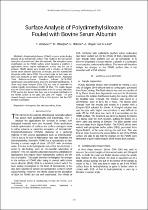JavaScript is disabled for your browser. Some features of this site may not work without it.
- ResearchSpace
- →
- Research Publications/Outputs
- →
- Conference Publications
- →
- View Item
| dc.contributor.author |
Windvoel, T

|
|
| dc.contributor.author |
Mbanjwa, M

|
|
| dc.contributor.author |
Mokone, N

|
|
| dc.contributor.author |
Mogale, A

|
|
| dc.contributor.author |
Land, K

|
|
| dc.date.accessioned | 2010-10-11T10:25:38Z | |
| dc.date.available | 2010-10-11T10:25:38Z | |
| dc.date.issued | 2010-01 | |
| dc.identifier.citation | Windvoel, T, Mbanjwa, M, Mokone, N et al. 2010. Surface analysis of polydimethylsiloxane fouled with bovine serum albumin. World Academy of Sciences, Engineering and Technology, Cape Town, 29-31 January 2010, pp 354-356 | en |
| dc.identifier.uri | http://www.waset.org/journals/waset/v61/v61-53.pdf | |
| dc.identifier.uri | http://hdl.handle.net/10204/4466 | |
| dc.description | World Academy of Sciences, Engineering and Technology, Cape Town, 29-31 January 2010 | en |
| dc.description.abstract | The interest in the analysis of biological materials surfaces has grown both academically and industrially. This is because the applications for surfaces in contact with biological materials have also increased. These applications include optimization of surfaces and surface coatings in order to either enhance or minimize adsorption of biomaterials. Polydimethylsiloxane (PDMS) elastomer is a preferred material in life science applications such as microfluidics. This is due to its ease of fabrication, low cost, inertness and biocompatibility. Normally, PDMS has a hydrophobic surface, forming a contact angle of about 107-110° with de-ionized water. It is due to its hydrophobic nature that the elastomer is prone to bio-fouling, such as non-specific adsorption of proteins. The non specific adsorption becomes a limitation in applications that require clean hydrophobic surfaces and the use of proteins. This paper investigates the changes in the surface of PDMS after being in contact with bovine serum albumin (BSA). BSA is a standard protein which has been widely investigated in the field of biomaterials. It has also been reported to adsorb on hydrophobic surfaces which causes fouling. However, the effects caused by the adsorption of BSA on PDMS are not well understood. The effects of BSA combined with surfactants (surface active molecules) have been studied but not the effects of BSA independently, even though some proteins can act as surfactants. It is important to know whether a protein is a surfactant or not and also understand its effects. This work will therefore analyze the changes on the PDMS surface after it has interacted with a BSA solution. | en |
| dc.language.iso | en | en |
| dc.publisher | World Academy of Sciences, Engineering and Technology | en |
| dc.relation.ispartofseries | Conference Paper | en |
| dc.subject | Polydimethylsiloxane | en |
| dc.subject | Bovine serum albumin | en |
| dc.subject | Adsorption | en |
| dc.title | Surface analysis of polydimethylsiloxane fouled with bovine serum albumin | en |
| dc.type | Conference Presentation | en |
| dc.identifier.apacitation | Windvoel, T., Mbanjwa, M., Mokone, N., Mogale, A., & Land, K. (2010). Surface analysis of polydimethylsiloxane fouled with bovine serum albumin. World Academy of Sciences, Engineering and Technology. http://hdl.handle.net/10204/4466 | en_ZA |
| dc.identifier.chicagocitation | Windvoel, T, M Mbanjwa, N Mokone, A Mogale, and K Land. "Surface analysis of polydimethylsiloxane fouled with bovine serum albumin." (2010): http://hdl.handle.net/10204/4466 | en_ZA |
| dc.identifier.vancouvercitation | Windvoel T, Mbanjwa M, Mokone N, Mogale A, Land K, Surface analysis of polydimethylsiloxane fouled with bovine serum albumin; World Academy of Sciences, Engineering and Technology; 2010. http://hdl.handle.net/10204/4466 . | en_ZA |
| dc.identifier.ris | TY - Conference Presentation AU - Windvoel, T AU - Mbanjwa, M AU - Mokone, N AU - Mogale, A AU - Land, K AB - The interest in the analysis of biological materials surfaces has grown both academically and industrially. This is because the applications for surfaces in contact with biological materials have also increased. These applications include optimization of surfaces and surface coatings in order to either enhance or minimize adsorption of biomaterials. Polydimethylsiloxane (PDMS) elastomer is a preferred material in life science applications such as microfluidics. This is due to its ease of fabrication, low cost, inertness and biocompatibility. Normally, PDMS has a hydrophobic surface, forming a contact angle of about 107-110° with de-ionized water. It is due to its hydrophobic nature that the elastomer is prone to bio-fouling, such as non-specific adsorption of proteins. The non specific adsorption becomes a limitation in applications that require clean hydrophobic surfaces and the use of proteins. This paper investigates the changes in the surface of PDMS after being in contact with bovine serum albumin (BSA). BSA is a standard protein which has been widely investigated in the field of biomaterials. It has also been reported to adsorb on hydrophobic surfaces which causes fouling. However, the effects caused by the adsorption of BSA on PDMS are not well understood. The effects of BSA combined with surfactants (surface active molecules) have been studied but not the effects of BSA independently, even though some proteins can act as surfactants. It is important to know whether a protein is a surfactant or not and also understand its effects. This work will therefore analyze the changes on the PDMS surface after it has interacted with a BSA solution. DA - 2010-01 DB - ResearchSpace DP - CSIR KW - Polydimethylsiloxane KW - Bovine serum albumin KW - Adsorption LK - https://researchspace.csir.co.za PY - 2010 T1 - Surface analysis of polydimethylsiloxane fouled with bovine serum albumin TI - Surface analysis of polydimethylsiloxane fouled with bovine serum albumin UR - http://hdl.handle.net/10204/4466 ER - | en_ZA |






